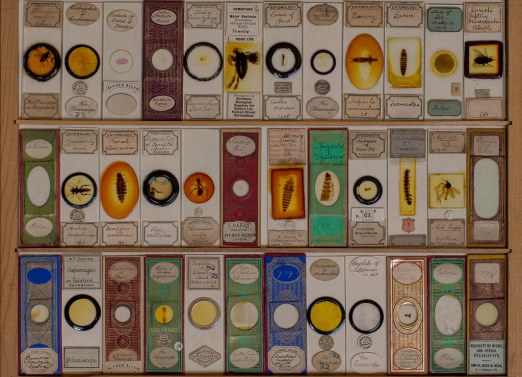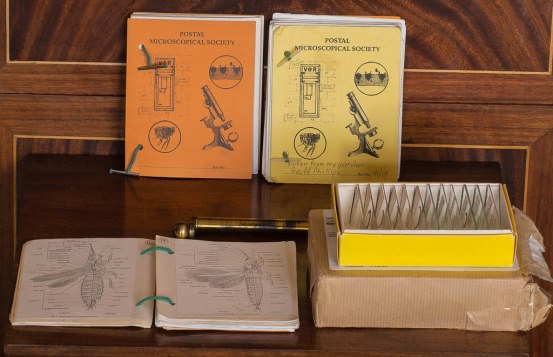Boxing Clever

Mike Samworth celebrates a 140 year old club that shares microscope slides by post
The Biologist 62(3) p22-23
Improvements to the optical microscope in the first half of the 19th century heralded a surge of interest in the instrument from both scientists and interested amateurs. In 1871, a letter written by Alfred Allen to the monthly periodical Science Gossip suggested a postal club to exchange slides and knowledge. Two years later, Alfred Atkinson sent a similar letter to the same periodical. It started a dialogue that resulted in a dozen members forming the Postal Microscopical Society (PMS).
In the early days, a box of microscope slides started with just one. Each successive member then added a slide, up to a dozen in each box. When the box was re-circulated, each member took out their slide and replaced it with another.
Later, as numbers increased, the PMS secretary and some other members made notes and drawings to accompany the slides. The society still has some of these notebooks. Members were also offered a journal, the first being in 1882, and bound copies of these are sometimes found at antiquarian book fairs and have considerable scientific value, even today.

As with any society, there were many highs and lows. Officers died, and it was sometimes difficult to find a replacement willing or able to put in the necessary time. This is true today, too. Postal charge rises caused problems, and the two world wars had a disastrous effect. In 1929, the membership reached a low of 21, putting the viability of the PMS in question. Thankfully, it currently has a healthy membership of several hundred, and modern printing methods result in less wastage in terms of publications.
Today, the principal objective of the PMS is still the circulation of boxes of microscope slides to illustrate the work of members and professional mounters. Members are organised into ‘circuits’, and boxes of slides are circulated, at four-week intervals, accompanied by notebooks in which each recipient records their comments, criticisms and perhaps additional notes on the mounts themselves, before passing the box on to the next member of their circuit.
As each box normally contains 12 slides, each member has the opportunity to study many different slides during the year. It is rare to receive a box that does not provide some level of interest and enjoyment to all individuals, regardless of their main field of interest. Often the difficulty is to part with it.
Members are actively encouraged to participate by making their own slides available for circulation, and this aspect is the lifeblood of the PMS. Members are mostly amateurs with an interest in the microscope and microscopy, so the subject matter varies greatly.
Some are interested in instrumentation or techniques, others specialise in petrology and making thin rock sections, while others are fascinated by the hidden world of organisms found in water, such as diatoms or protozoa.
The essence of the society is the friendly and helpful interchange of information. Help is offered to beginners and experts alike by fellow members with experience or specialised knowledge in particular fields. Help is only a postage stamp, phone call or email away, and the beginner has access to a mine of information.
Balsam Post, the PMS’s newsletter, is published four times a year. Written by members for members, this is another source of advice, news, help and guidance. The aim is to provide information and instruction, and to be practical and helpful. Many back issues are available, and these alone provide a wealth of reading and are full of helpful information. All members are encouraged to contribute on any subject allied to microscopy and natural history, and a comprehensive index is now available.
Several meetings are held between March and October each year, and these give an opportunity to hold an exhibition on microscopical related subjects. Members share techniques, examples of their slides, photomicrographs or give a display. There are also very useful sales tables, which enable members to find a long wanted accessory, slide making equipment or a dream instrument.
The Postal Microscopical Society continues to attract new members and new slides onto the circuit. Happy reading, slide making and viewing – and here’s to another 140 years of postal microscopy.
Mike Samworth is the secretary of the Postal Microscopical Society. He has various microscopical interests, including pond life, especially diatoms, other algae and aquatic insects.
Under the microscope
Common interests of PMS members
Diatoms
Microscopists have been interested in these microscopic algae for hundreds of years. While some enjoy viewing them live, it is more common to ‘clean’ them by digesting the living part, leaving behind the often finely sculptured frustule, which is made of silica. Arranging these in patterns on slides is an art form.
Petrology/minerology
You can view all sorts of rocks and minerals under the microscope. In particular, thin sections of rock viewed between crossed polars can be beautiful and instructive.
Histology
Animal and plant tissues have been shown sectioned on slides for centuries. Some members are adept at collecting and mounting their own material from nature, carrying out the whole process, from sectioning and staining to mounting.
Photomicrography
A number of members like to take photographs through the microscope. Digital photography has had a huge impact here, as it allows experimentation at low cost.
Insects
Many smaller insects lend themselves to mounting on slides, including beetles mounted dry, in addition to cleared and squashed specimens.
Freshwater life
A favourite of many when they first start using the microscope. Nothing beats a little pond dipping to reveal a hidden world of protozoans, or the bewitching behaviour of rotifers or tardigrades.
Find out more on the Postal Microscopy Society's website.


